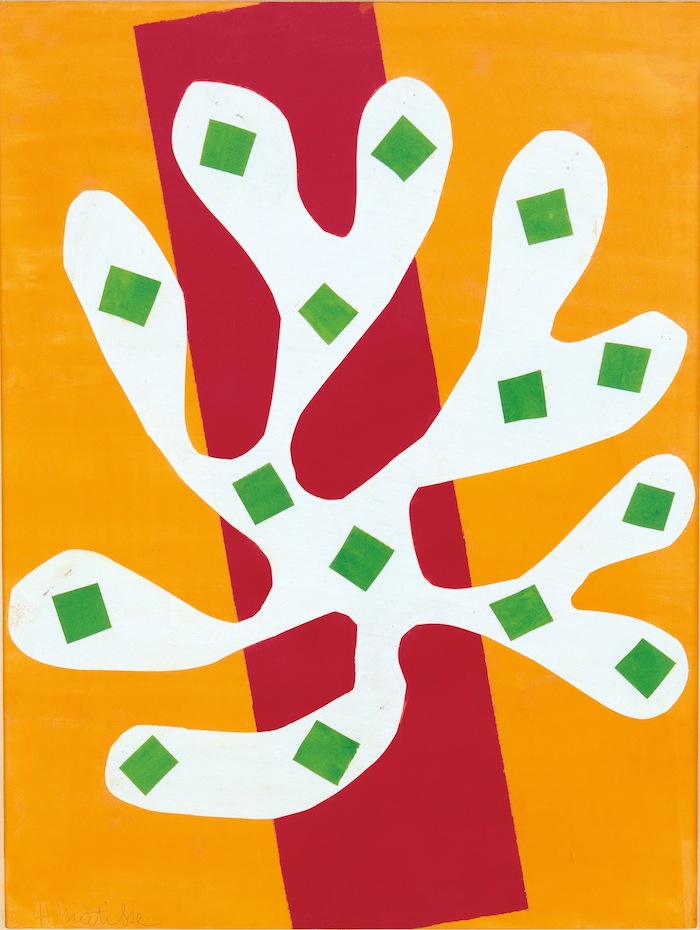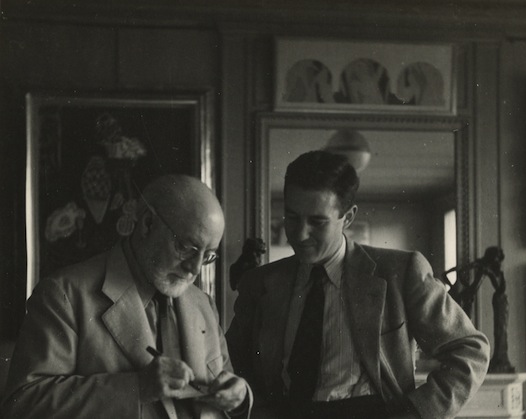
1.
On August 5th 1946, two years after Paris was liberated from the Germans, a young American soldier named Jerome Seckler visited Henri Matisse. Seckler had a passion for modern art. He made it his mission to meet with, and interview, some of the leading French artists of the time: Matisse was on his list.
Until now this interview has never been published.
.jpg)
2.
Only a few months earlier Matisse was living in Vence, along the Côte d'Azur. He had been suffering from duodenal cancer for five years at this point and was often overcome with pain that made him toss and groan through the night. A nurse would massage his legs, make him herbal tea, and read to him by a dim light. Although this physical nightmare persisted, his imagination flourished.
When Pablo Picasso and Francoise Gilot visited him in Vence, they found him sitting up in bed (his painting practice sharply curtailed), armed with a pair of giant scissors, holding a sheet of colored paper in one hand while a flurry of clippings—what would become known as the "cut-outs"—cascaded onto the bed covers around him. Picasso was stunned into silence. “We sat there like stones,” Gilot later recalled.
When Pablo Picasso and Francoise Gilot visited him in Vence, they found him sitting up in bed (his painting practice sharply curtailed), armed with a pair of giant scissors, holding a sheet of colored paper in one hand while a flurry of clippings—what would become known as the "cut-outs"—cascaded onto the bed covers around him. Picasso was stunned into silence. “We sat there like stones,” Gilot later recalled.
Later that spring, in the twilight of his sleepless nights, memories of Tahiti, where Matisse had lived and painted in 1930, came back to him with “tenderness and clarity.” That summer, he returned to the family apartment on the Boulevard du Montparnasse in Paris, where the walls were covered with a sand-brown fabric that had not been altered since 1926.
One night he handed his night nurse a paper cut out of a swallow to cover a stain on the wall. It was made from white writing paper, the only kind available in newly postwar Paris, rather than the colorful papers he had access to in Vence.
Over the next few weeks he would cover the wall, turning it into an imaginary lagoon with fish and waving seaweed, dolphins and seabirds. It would later become Oceania, The Sea and Oceania, The Sky.

3.
It was in those very rooms that Seckler came to interview Matisse. The transcripts have been generously made available to me and to Design Observer by Jerome's son, Donald Seckler. The interview reveals Jerome to be keenly interested and articulate in the art of time, and Matisse to be a spirited foil to Seckler's germane questioning. The transcript has been sitting neatly filed in a cardboard box for almost seventy years.
Running to nearly 3000 words, Seckler conducted the interview in French and later translated it into English by hand. Never before published, we will be running the unedited English translation of the interview in three installments.
Read on for part 1.

++
Jerome Seckler: What is the importance of the subject in painting?
Henri Matisse: You are posing a question. A book would be necessary to answer it. The question is complex, very complex. Today some people find that a subject is not necessary. Myself, I always have a subject. The subject is myself and what I see. Without a subject why should one work—just to cover the painting?
JS: I have spoken to a number of very good French painters and many of them insist that the subject is of no importance.
HM: It is always necessary to start off from a subject, even if one leaves it afterwards. It is the woman who is pretty, who pleases you, the landscape which has a particular form which corresponds to your sensitivity. I have always worked with a subject, it is always a subject which puts me in the mood. I am not able to talk about what the others say. The main thing is to work on a theme which inspires me.
JS: Your own choice of subject, or point of departure seems almost always to revolve around flowers and women, like a theme with variations.
HM: Before working I used to take a walk I walked in my garden. Before working in my studio I look at the flowers, a tree, a form of branch. I am enchanted by flowers, by a combination of lines. When I return, I am [well] nourished by that and I make something else, something completely different. This criticism that I work in my studio, that doesn’t matter. It is the result that counts. When I am very much criticized by a painter, I’ll say to him, put your work beside mine and we will see.” It is Cezanne who invented this criticism against me. I remember an American who wanted to go to the South of France and he asked me for some information, “Are there houses there like in the landscapes of Cezanne?” I had a studio of students. One of the students speaking to Gertrude Stein repeated my words. “We are Americans, tell me that in English,” she answered him. No, it is not the same thing. He retained the words and not the idea.
JS: I read a quote where you say you do the paintings sitting in a chair.
I said that forty years ago in 1906. [Here he had his secretary locate a book in a small bookcase beside his bed]. Yes, forty years ago, and I found myself tied up with it for my whole life. People have repeated it so many times that it has become a slogan. I think that art must not be a disagreeable thing. There is enough unhappiness in life to turn one towards the joy. One should keep the disagreeable, the unhappiness to himself. One can always find a pleasant thing. An unhappiness doesn’t remain. It makes experience. One doesn’t need to infect people with his annoyances. One should make a serene thing. One should make a stimulating art which leads the spirit of the spectator into a domain which puts him outside of his annoyances.
JS: Yet men like Goya and Daumier never evaded the harsher realities of life. And today we have a Guernica. Look at literature. Shakespeare, Milton, Balzac are great precisely because they were able to show the all-sidedness of life.
HM: Plastic art has the advantage over literature in that it is more vast. Literature is a precise thing. The plastic sense is a thing above that and more vast. For the simple man, for the worker there should be something in a painting which will please him and in which it is only his sensitivity which will enable him to appreciate it. A man with money will appreciate a painting for the price but the man in the street will just like the painting because he will feel it is good even if he doesn’t know why. The banker will say about a painting, “it is as good as the others are because it is the same price, 200,000 francs.”
JS: There is a great deal of talk especially by hostile art critics that modern art is the equivalent of a fraud, that the artist is trying to put something over on the public. And although the public accepts modern art when incorporated into architecture, advertisements, posters, and even household articles, it still refuses to accept modern painting. What do think can be done to close this gap?
HM: Who occupies himself with that question? They are the painters and the critics. It began that way, criticized by everybody, but I didn’t bother myself about it. I said to myself, “when what I paint will be clearly expressed, everybody will understand.” I continued and I have been admitted.
One is never understood, one is admitted. Painters have only to work sincerely with nature or without nature if they have a big enough brain and the public will come after. A chef doesn’t have to always ask for approval and to ask [others] people to taste the plates that he prepares. If you must trouble yourself with the public, painting, its art, what one has to say, one cannot arrive, it is too complicated.
There is art, the project of making paintings, and what you feel. It is necessary to make a thing which is in a clear language. One day this painting will be admitted, but you can do nothing to advance that. I have always seen those who liked painting, they were the ones who didn’t have a [son?]. I once learned a man like that was following my exhibitions for twenty years and nobody knew it. People have never spoken as much of painting as now. I hope that the painter today is good, but I am not sure. In each epoque there are a certain number of artists who have counted. There is no need to have a regiment of painters. There are some artists only in each epoque. The painters believe that they exist because people speak of them. It is more simple and more difficult than that. There are several good painters in each epoque but these are very few for all those who are bad painters.
++
This interview is published by permission of Donald Seckler. I'm indebted to Hilary Spurling’s Matisse the Master. The editors would like to thank Marisa Nakasone for her transcription help.
++
Read Part II here and Part III here.
Henri Matisse, White Alga on Orange and Red Background (Algue blanche sur fond orange et rouge), 1947. Gouache on paper, cut and pasted. 20 11/16 x 15 15/16 (52.5 x 40.5 cm). Mr. and Mrs. Donald B. Marron, New York. © 2015 Succession H. Matisse / Artists Rights Society (ARS), New York
Henri Matisse in front of gouache-painted papers, Hôtel Régina, Nice. Photo: Lydia Delectorskaya. © 2014 Succession H. Matisse
Installation view of Henri Matisse: The Cut-Outs at The Museum of Modern Art, New York. Photo: Jonathan Muzikar. © 2014 The Museum of Modern Art
Henri Matisse and Jerome Seckler, Paris, August 1946. Photo courtesy Donald Seckler.
++
Read Part II here and Part III here.
Images:
Henri Matisse, White Alga on Orange and Red Background (Algue blanche sur fond orange et rouge), 1947. Gouache on paper, cut and pasted. 20 11/16 x 15 15/16 (52.5 x 40.5 cm). Mr. and Mrs. Donald B. Marron, New York. © 2015 Succession H. Matisse / Artists Rights Society (ARS), New York
Henri Matisse in front of gouache-painted papers, Hôtel Régina, Nice. Photo: Lydia Delectorskaya. © 2014 Succession H. Matisse
Installation view of Henri Matisse: The Cut-Outs at The Museum of Modern Art, New York. Photo: Jonathan Muzikar. © 2014 The Museum of Modern Art
Henri Matisse and Jerome Seckler, Paris, August 1946. Photo courtesy Donald Seckler.
